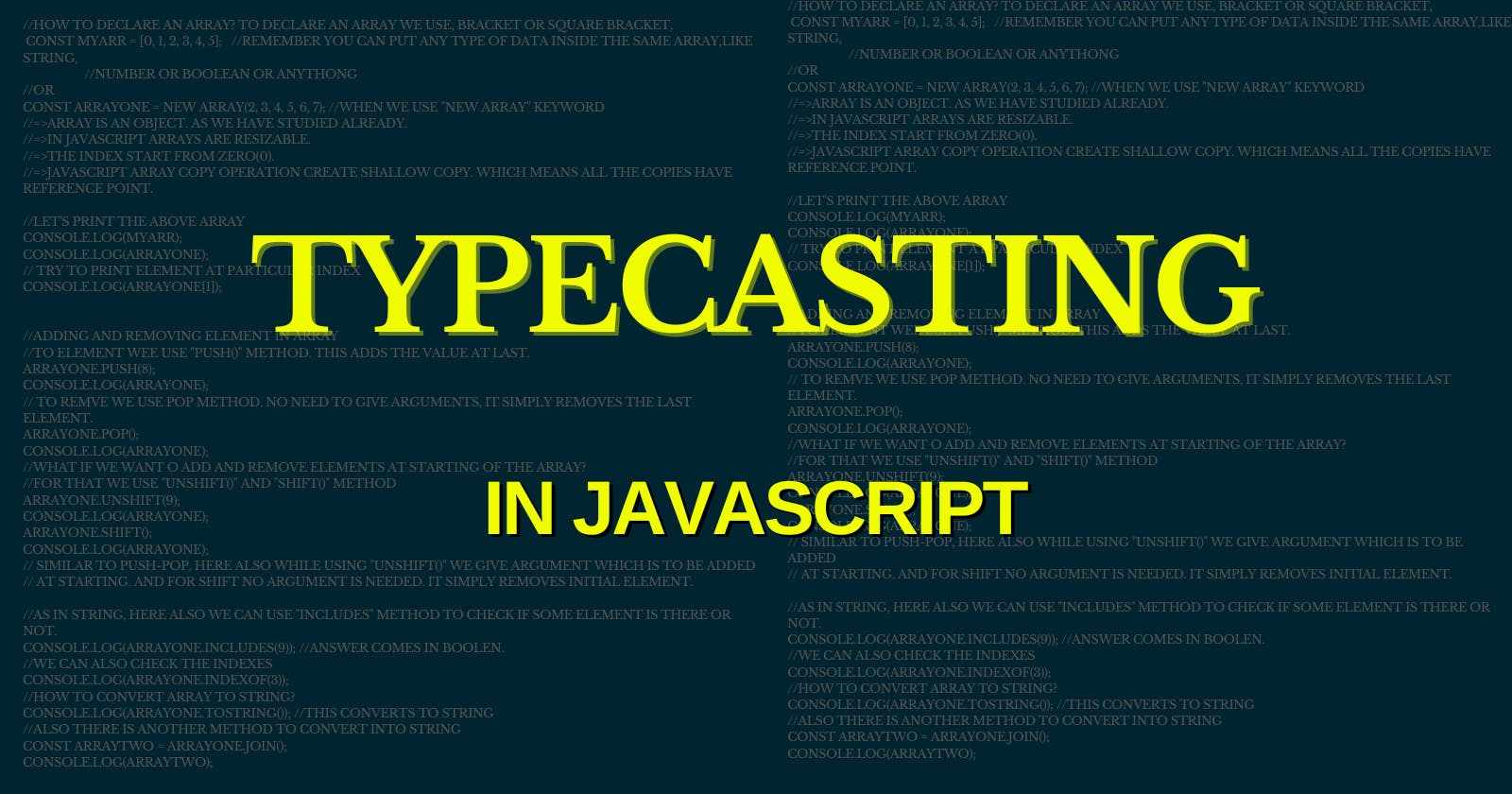Table of contents
JavaScript is a dynamically-typed language, which means that variables are not bound to a specific data type at the time of declaration. This flexibility allows for a wide range of operations but can sometimes lead to unexpected results. Typecasting is the process of converting one data type into another, and it plays a crucial role in JavaScript. In this blog post, we'll explore typecasting in JavaScript, including explicit typecasting, implicit typecasting, and the difference between type conversion and coercion.
Explicit Typecasting
Explicit typecasting, also known as type conversion, occurs when you intentionally change the data type of a value from one type to another. JavaScript provides a few built-in functions and methods to perform explicit typecasting. Let's look at some common examples:
String to Number Conversion:
You can use
parseInt()andparseFloat()functions to convert a string to a number.javascriptCopy codelet numString = "42"; let num = parseInt(numString); // Converts to integer console.log(num); // Output: 42Number to String Conversion:
You can use
toString()to convert a number to a string.javascriptCopy codelet num = 42; let str = num.toString(); console.log(str); // Output: "42"Boolean to String Conversion:
You can use
String()to convert a boolean to a string.javascriptCopy codelet bool = true; let str = String(bool); console.log(str); // Output: "true"Date to String Conversion:
You can use
toString()to convert a date object to a string.javascriptCopy codelet currentDate = new Date(); let dateStr = currentDate.toString(); console.log(dateStr); // Outputs the current date and time as a stringString to Array Conversion:
You can use
split()to convert a comma-separated string into an array.javascriptCopy codelet fruitsString = "apple,banana,cherry"; let fruitsArray = fruitsString.split(","); console.log(fruitsArray); // Output: ["apple", "banana", "cherry"]Number to Boolean Conversion:
You can use the double negation (
!!) to explicitly convert a number to a boolean.javascriptCopy codelet num = 42; let bool = !!num; console.log(bool); // Output: trueString to Number with Floating-Point Conversion:
You can use
parseFloat()to convert a string to a floating-point number.javascriptCopy codelet floatString = "3.14"; let floatNum = parseFloat(floatString); console.log(floatNum); // Output: 3.14String to Integer with Radix Conversion:
You can use
parseInt()with a radix to convert a string to an integer.javascriptCopy codelet binaryString = "1010"; let decimalNum = parseInt(binaryString, 2); // Parses as binary console.log(decimalNum); // Output: 10
Explicit typecasting allows you to have more control over your data types and is especially useful when you need to perform specific operations where data types matter.
Implicit Typecasting
Implicit typecasting, also known as type coercion, occurs when JavaScript automatically converts data types during an operation or comparison. This behavior can lead to unexpected results if you're not aware of how JavaScript handles type coercion. Here are a few examples:
String and Number Concatenation:
When you use the
+operator to concatenate a string and a number, JavaScript implicitly converts the number to a string and performs concatenation.javascriptCopy codelet str = "The answer is: " + 42; console.log(str); // Output: "The answer is: 42"Number and Boolean Comparison:
When you use comparison operators like
==or!=, JavaScript implicitly converts between different data types to compare them. For example, it treatstrueas1andfalseas0.javascriptCopy codeconsole.log(1 == true); // Output: true console.log(0 == false); // Output: trueString and Boolean Comparison:
When you use comparison operators with strings and booleans, JavaScript implicitly converts them. An empty string (
"") is treated asfalse, and a non-empty string astrue.javascriptCopy codeconsole.log("hello" == true); // Output: false console.log("" == false); // Output: trueArithmetic Operations:
When you perform arithmetic operations with mixed data types, JavaScript implicitly converts them to a common data type (usually a number).
javascriptCopy codelet result = 5 * "5"; // Implicitly converts "5" to a number console.log(result); // Output: 25Logical Operations:
In logical operations, JavaScript implicitly converts values to booleans. For example,
0,null,undefined,NaN, and empty strings are considered asfalse, while other values aretrue.javascriptCopy codelet value = "text"; if (value) { console.log("Value is truthy"); // Output: "Value is truthy" } else { console.log("Value is falsy"); }Array to String Conversion:
When you use an array in a string context, JavaScript implicitly converts the array to a comma-separated string.
javascriptCopy codelet myArray = [1, 2, 3]; let arrayString = "Array elements: " + myArray; console.log(arrayString); // Output: "Array elements: 1,2,3"Unary Plus Operator:
The unary plus operator (
+) can be used for implicit type conversion to numbers.javascriptCopy codelet numericString = "42"; let num = +numericString; // Implicitly converts to a number console.log(num); // Output: 42
Type Conversion vs. Coercion
Type conversion and coercion are often used interchangeably, but they have distinct meanings. Type conversion refers to the explicit and intentional changing of data types using built-in functions like Number(), String(), and Boolean(). It gives you control over the transformation process and is predictable.
On the other hand, type coercion is implicit and automatic. JavaScript tries to make sense of operations involving different data types by converting them on-the-fly. While this can be convenient, it can also lead to unexpected results if you're not careful. It's essential to understand how type coercion works to avoid bugs in your code.
In conclusion, typecasting plays a crucial role in JavaScript. Whether you're explicitly converting data types using built-in functions or dealing with implicit type coercion, understanding these concepts will help you write more robust and predictable JavaScript code. By knowing when and how typecasting occurs, you can harness the power of JavaScript while avoiding common pitfalls.
you can learn JavaScript by following the JavaScript series. Follow me and subscribe to the newsletter to get notified.
